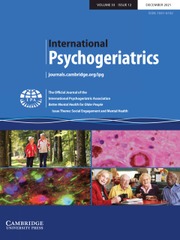Crossref Citations
This article has been cited by the following publications. This list is generated based on data provided by
Crossref.
Zhang, Casper J P
Barnett, Anthony
Sit, Cindy H P
Lai, Poh-chin
Johnston, Janice M
Lee, Ruby S Y
and
Cerin, Ester
2018.
Cross-sectional associations of objectively assessed neighbourhood attributes with depressive symptoms in older adults of an ultra-dense urban environment: the Hong Kong ALECS study.
BMJ Open,
Vol. 8,
Issue. 3,
p.
e020480.
Nathan, Andrea
Villanueva, Karen
Rozek, Julianna
Davern, Melanie
Gunn, Lucy
Trapp, Gina
Boulangé, Claire
and
Christian, Hayley
2018.
The Role of the Built Environment on Health Across the Life Course: A Call for CollaborACTION.
American Journal of Health Promotion,
Vol. 32,
Issue. 6,
p.
1460.
Cerin, Ester
Nathan, Andrea
Choi, Wing Ka
Ngan, Winsfred
Yin, Shiyuan
Thornton, Lukar
and
Barnett, Anthony
2019.
Built and social environmental factors influencing healthy behaviours in older Chinese immigrants to Australia: a qualitative study.
International Journal of Behavioral Nutrition and Physical Activity,
Vol. 16,
Issue. 1,
Luo, Ye
2019.
Encyclopedia of Gerontology and Population Aging.
p.
1.
Cerin, Ester
2019.
Building the evidence for an ecological model of cognitive health.
Health & Place,
Vol. 60,
Issue. ,
p.
102206.
Rodriguez-Ruiz, Julieta G.
Galvan-Tejada, Carlos E.
Vazquez-Reyes, Sodel
Galvan-Tejada, Jorge I.
and
Gamboa-Rosales, Hamurabi
2019.
Nighttime Depression Episodes Classification using a Formal Method: Knowledge Discovery in Databases.
p.
207.
Motoc, I.
Timmermans, E.J.
Deeg, D.
Penninx, B.W.J.H.
and
Huisman, M.
2019.
Associations of neighbourhood sociodemographic characteristics with depressive and anxiety symptoms in older age: Results from a 5-wave study over 15 years.
Health & Place,
Vol. 59,
Issue. ,
p.
102172.
Besser, Lilah
Galvin, James E.
Rodriguez, Daniel
Seeman, Teresa
Kukull, Walter
Rapp, Stephen R.
and
Smith, Jennifer
2019.
Associations between neighborhood built environment and cognition vary by apolipoprotein E genotype: Multi-Ethnic Study of Atherosclerosis.
Health & Place,
Vol. 60,
Issue. ,
p.
102188.
De Donder, Liesbeth
Smetcoren, An-Sofie
Schols, Jos M.G.A.
van der Vorst, Anne
and
Dierckx, Eva
2019.
Critical reflections on the blind sides of frailty in later life.
Journal of Aging Studies,
Vol. 49,
Issue. ,
p.
66.
Baranyi, Gergő
Sieber, Stefan
Pearce, Jamie
Cheval, Boris
Dibben, Chris
Kliegel, Matthias
and
Cullati, Stéphane
2019.
A longitudinal study of neighbourhood conditions and depression in ageing European adults: Do the associations vary by exposure to childhood stressors?.
Preventive Medicine,
Vol. 126,
Issue. ,
p.
105764.
Boakye-Dankwa, Ernest
Barnett, Anthony
Pachana, Nancy A.
Turrell, Gavin
and
Cerin, Ester
2019.
Associations Between Latent Classes of Perceived Neighborhood Destination Accessibility and Walking Behaviors in Older Adults of a Low-Density and a High-Density City.
Journal of Aging and Physical Activity,
Vol. 27,
Issue. 4,
p.
553.
Zhang, Casper J. P.
Barnett, Anthony
Johnston, Janice M.
Lai, Poh-chin
Lee, Ruby S. Y.
Sit, Cindy H. P.
and
Cerin, Ester
2019.
Objectively-Measured Neighbourhood Attributes as Correlates and Moderators of Quality of Life in Older Adults with Different Living Arrangements: The ALECS Cross-Sectional Study.
International Journal of Environmental Research and Public Health,
Vol. 16,
Issue. 5,
p.
876.
Kim, Eunhae
Gellis, Zvi D.
Bradway, Christine
and
Kenaley, Bonnie
2019.
Key Determinants to using Telehealth Technology to Serve Medically Ill and Depressed Homebound Older Adults.
Journal of Gerontological Social Work,
Vol. 62,
Issue. 4,
p.
451.
Gunn, Lucy D.
2020.
Can a liveable city be a healthy city, now and into the future?.
Internal Medicine Journal,
Vol. 50,
Issue. 11,
p.
1405.
Maj, Mario
Stein, Dan J.
Parker, Gordon
Zimmerman, Mark
Fava, Giovanni A.
De Hert, Marc
Demyttenaere, Koen
McIntyre, Roger S.
Widiger, Thomas
and
Wittchen, Hans‐Ulrich
2020.
The clinical characterization of the adult patient with depression aimed at personalization of management.
World Psychiatry,
Vol. 19,
Issue. 3,
p.
269.
Kim, Bongjeong
2020.
Factors Influencing Depressive Symptoms in the Elderly: Using the 7th Korea National Health and Nutrition Examination Survey (KNHANES VII-1).
Journal of Health Informatics and Statistics,
Vol. 45,
Issue. 2,
p.
165.
Tamura, Kosuke
Langerman, Steven D.
Orstad, Stephanie L.
Neally, Sam J.
Andrews, Marcus R.
Ceasar, Joniqua N.
Sims, Mario
Lee, Jae E.
and
Powell-Wiley, Tiffany M.
2020.
Physical activity-mediated associations between perceived neighborhood social environment and depressive symptoms among Jackson Heart Study participants.
International Journal of Behavioral Nutrition and Physical Activity,
Vol. 17,
Issue. 1,
Rodríguez-Ruiz, J. G.
Galván-Tejada, C. E.
Vázquez-Reyes, S.
Galván-Tejada, J. I.
and
Gamboa-Rosales, H.
2020.
Classification of Depressive Episodes Using Nighttime Data; a Multivariate and Univariate Analysis.
Programming and Computer Software,
Vol. 46,
Issue. 8,
p.
689.
Benjet, Corina
Axinn, William G.
Hermosilla, Sabrina
Schulz, Paul
Cole, Faith
Sampson, Laura
and
Ghimire, Dirgha
2020.
Exposure to Armed Conflict in Childhood vs Older Ages and Subsequent Onset of Major Depressive Disorder.
JAMA Network Open,
Vol. 3,
Issue. 11,
p.
e2019848.
Domènech-Abella, Joan
Mundó, Jordi
Leonardi, Matilde
Chatterji, Somnath
Tobiasz-Adamczyk, Beata
Koskinen, Seppo
Ayuso-Mateos, Jose Luis
Haro, Josep Maria
and
Olaya, Beatriz
2020.
Loneliness and depression among older European adults: The role of perceived neighborhood built environment.
Health & Place,
Vol. 62,
Issue. ,
p.
102280.


